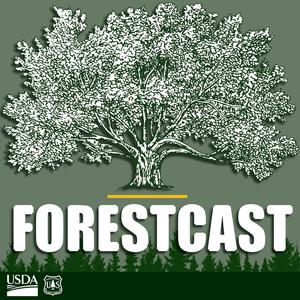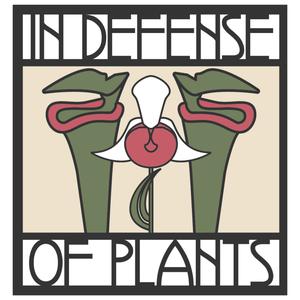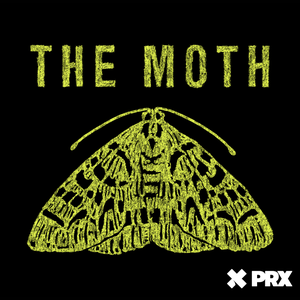
Forestcast
USDA Forest Service
- 48 minutes 22 secondsAfire: Fire Ignition, Mitigation & Recovery
Fire shapes landscapes and lives, but how do humans shape fire? By measuring wildfire ignition, mitigation, and recovery, as well as the wildland-urban interface—where houses meet or intermingle with undeveloped wildland vegetation—scientists are uncovering the complex dynamics between wildfire and human behavior.
Research social scientist, Miranda Mockrin, sheds light on the rapidly growing wildland-urban interface and the challenges it poses for fire management and community resilience. Research forester, Jeff Kline, delves into private landowners' behavior in central Oregon, and the surprising insights into their awareness of fire risks and the factors influencing their mitigation actions. Kline also investigates the various ways humans cause wildfires across the Pacific Northwest, and what can be done with that data.
Related Research:
- Changes to Rural Migration in the COVID-19 Pandemic (2024)
- Rising Wildfire Risk to Houses in the US, Especially in Grasslands and Shrublands (2023)
- The Global Wildland–Urban Interface (2023)
- Tale of Two Fires: Retreat and Rebound a Decade After Wildfires in California and South Carolina (2022)
- After the fire: Perceptions of Land Use Planning to Reduce Wildfire Risk in Eight Communities Across the United States (2020)
- Where Wildfires Destroy Buildings in the U.S. Relative to the WUI and National Fire Outreach Programs (2018)
- Sprawling & Diverse: The Changing U.S. Population and Implications for Public Lands in the 21st Century (2018)
- Rebuilding and New Housing Development After Wildfire (2015)
- Adapting to Wildfire: Rebuilding After Home Loss (2015)
- The Wildland Urban Interface Fire Problem (2008)
- Wildfire Strikes Home!: The Report of the National Wildland/Urban Fire Protection Conference (1987)
- The Influence of Socioeconomic Factors on Human Wildfire Ignitions in the Pacific Northwest, USA (2023)
- Spatial Wildfire Occurrence Data for the United States, 1992-2020 (2022)
- Examining the Influence of Biophysical Conditions on Wildland-Urban Interface Homeowners' Wildfire Risk Mitigation Activities in Fire-Prone Landscapes (2017)
- A Conceptual Framework for Coupling the Biophysical and Social Dimensions of Wildfire to Improve Fireshed Planning and Risk Mitigation (2015)
Scientists:
- Miranda Mockrin, Research Social Scientist, Baltimore, Maryland
- Jeff Kline, Research Forester, Corvallis, Oregon
Forestcast is an official USDA Forest Service podcast, and is produced by USDA Forest Service Research and Development.
Want more information? Visit us at https://www.fs.usda.gov/research/products/multimedia/forestcast
Questions or ideas for the show? Contact Jon at [email protected]
15 May 2024, 9:00 am - 51 minutes 45 secondsAfire: Fire Effects Above and Belowground
Fire affects forests above and belowground. Travel along on a multiscale journey from forest-wide influences to molecular-level changes, unraveling the knowns and unknowns of fire effects on soil, vegetation, and carbon.
Sharon Hood explains how fire affects tree mortality, tracing the pivotal role of carbohydrates in a tree's post-fire survival. Dexter Strother investigates the production and persistence of black carbon in soils, shedding light on its potential climate implications. Matt Dickinson shares innovative techniques for measuring belowground heat transfer during fires, and unveils the intricate effects on soil nutrients and microbial life.
Related Research:
- Long-term Efficacy of Fuel Reduction and Restoration Treatments in Northern Rockies Dry Forests (2024)
- Nonstructural Carbohydrates Explain Post-fire Tree Mortality and Recovery Patterns (2024)
- How Effective are Landscape Scale Fuel Treatments? (2023)
- Understanding Post-fire Tree Mortality: Resources & Research
- Lubrecht Fire-Fire Surrogate Study
- Fire Exclusion Reduces A‐horizon Thickness in a Long‐term Prescribed Fire Experiment in Spodosols of Northern Florida, USA (2023)
- Canopy-derived Fuels Drive Patterns of In-fire Energy Release and Understory Plant Mortality in a Longleaf Pine Sandhill in Northwest Florida, USA (2016)
- Soil Heating in Fires: Process, Measurement, and Effects (2023)
- Soil Heating in Fire (SheFire): A Model and Measurement Method for Estimating Soil Heating and Effects During Wildland Fires (2022)
- Beyond "Fire Temperatures": Calibrating Thermocouple Probes and Modeling Their Response to Surface Fires in Hardwood Fuels (2008)
- Temperature-Dependent Rate Models of Vascular Cambium Cell Mortality (2004)
Scientists:
- Sharon Hood, Research Ecologist, Missoula, Montana
- Dexter Strother, Research Ecologist, Athens, Georgia
- Matt Dickinson, Research Ecologist, Delaware, Ohio
Forestcast is an official USDA Forest Service podcast, and is produced by USDA Forest Service Research and Development.
Want more information? Visit us at https://www.fs.usda.gov/research/products/multimedia/forestcast
Questions or ideas for the show? Contact Jon at [email protected]
8 May 2024, 8:45 am - 58 minutes 14 secondsAfire: Fire Weather, Wind & Smoke
From whipping winds that fan flames to swirling smoke that obscures visibility, fire weather is a complex phenomenon. In Episode 4 of "Afire," hear from three meteorologists at the intersection of the intricate relationships between fire weather, wind, and smoke.
Brian Potter explains how large-scale atmospheric patterns, like extended dry periods before a wildfire, may contribute to the development of extreme fire events. Natalie Wagenbrenner discusses WindNinja, a high-resolution wind model that simulates local winds in complex terrain. And Scott Goodrick investigates the turbulent dynamics of small‑scale surface fires, as well as superfog—dense smoke-enhanced fog that can severely reduce visibility.
Related Research:
- National Prescribed Fire Program Review (2022)
- Investigating the Turbulent Dynamics of Small-Scale Surface Fires (2022)
- Microscale Wind Modeling: WindNinja for Fire Management (2021)
- Downscaling Surface Wind Predictions from Numerical Weather Prediction Models in Complex Terrain with a Mass-Consistent Wind Model (2016)
- A Comparison of Three Approaches for Simulating Fine-Scale Surface Winds in Support of Wildland Fire Management (Part 1) (Part 2) (2014)
- Smoke 101 & Differences Between Wildfire and Prescribed Fire Smoke in the Western U.S. (2024)
- Fire Behaviour and Smoke Modelling: Model Improvement and Measurement Needs for Next-Generation Smoke Research and Forecasting Systems (2019)
- Laboratory and Numerical Modeling of the Formation of Superfog from Wildland Fires (2019)
- On the Formation and Persistence of Superfog in Woodland Smoke (2009)
Scientists:
- Brian Potter, Research Meteorologist, Seattle, Washington
- Natalie Wagenbrenner, Research Meteorologist, Missoula, Montana
- Scott Goodrick, Research Meteorologist, Athens, Georgia
Forestcast is an official USDA Forest Service podcast, and is produced by USDA Forest Service Research and Development.
Want more information? Visit us at https://www.fs.usda.gov/research/products/multimedia/forestcast
Questions or ideas for the show? Contact Jon at [email protected]
1 May 2024, 8:45 am - 51 minutes 30 secondsAfire: Understanding Different Fire
Prescribed fire plays a vital role in creating healthy landscapes that better survive natural and human-caused disturbances, while reducing wildfire risk to communities, infrastructure, and natural and cultural resources. Episode 3 of "Afire" highlights three scientists and partnerships that are attempting to better understand and utilize prescribed fire.
From Georgia, ecologist Joe O’Brien explains how researchers and forest managers are forming unique meetings that spark fresh ideas and advancements in prescribed burning across the South. In California, forester David Weise begins research into the processes related to pyrolysis to better estimate how prescribed burning affects people. And, in Arkansas, forestry technician Virginia McDaniel recounts a decades-long story of prescribed fire fortifying an ecosystem and an endangered woodpecker.
Related Research:
- Prescribed Fire Science: The Case for a Refined Research Agenda (2020)
- Comparing Two Methods to Measure Oxidative Pyrolysis Gases in a Wind Tunnel and in Prescribed Burns (2022)
- Comparison of Pyrolysis of Live Wildland Fuels Heated by Radiation vs. Convection (2020)
- A Project to Measure and Model Pyrolysis to Improve Prediction of Prescribed Fire Behavior (2018)
- Particulate & Trace Gas Emissions from Prescribed Burns in Southeastern U.S. (2015)
- Diversity Explodes with Another Boring Burn with USDA Forest Service’s Virginia McDaniel (2023)
- Pine-Bluestem Literature Review (2013)
- Renewal of the Shortleaf Pine-Bluestem Grass Ecosystem (2010)
Scientists:
- Joe O'Brien, Research Ecologist, Southern Research Station, Athens, Georgia
- David Weise, Research Forester, Pacific Southwest Research Station, Riverside, California
- Virginia McDaniel, Forestry Technician, Southern Research Station, Hot Springs, Arkansas
Forestcast is an official USDA Forest Service podcast, and is produced by USDA Forest Service Research and Development.
Want more information? Visit us at https://www.fs.usda.gov/research/products/multimedia/forestcast
Questions or ideas for the show? Contact Jon at [email protected]
24 April 2024, 8:45 am - 48 minutes 21 secondsAfire: Understanding Fire Differently
Indigenous tribes gained their unique understanding of fire, and the role of fire on the landscape, long before European settlers came to what is now called North America. Since then, the relationship between federal fire management and indigenous perspectives has often been one of misunderstanding and mistrust. On Episode 2 of "Afire," join Forest Service scientists, Frank Kanawha Lake, a tribal descendant, and Serra Hoagland, a tribal member, as they explain the ways in which Forest Service fire research is collaborating with tribes to jointly strive to better understand and manage fire.
Related Research:
- Partnering in Research About Land Management with Tribal Nations—Insights from the Pacific West (2023)
- Wildlife Stewardship on Tribal Lands (2023)
- Using Culturally Significant Birds to Guide the Timing of Prescribed Fires in the Klamath Siskiyou Bioregion (2023)
- Prescribed Fire Reduces Insect Infestation in Karuk and Yurok Acorn Resource Systems (2022)
- Getting More Fire on the Ground: Landscape-Scale Prescribed Burning Supported by Science (2022)
- Spatial and Temporal Dynamics of Mexican Spotted Owl hHabitat in the Southwestern US (2022)
- An Assessment of American Indian Forestry Research, Information Needs, and Priorities (2022)
- Revitalized Karuk and Yurok Cultural Burning to Enhance California Hazelnut for Basketweaving in Northwestern California, USA (2021)
- Indigenous Fire Stewardship: Federal/Tribal Partnerships for Wildland Fire Research and Management (2021)
- The Importance of Indigenous Cultural Burning in Forested Regions of the Pacific West, USA (2021)
- Is Fire “For the Birds”? How Two Rare Species Influence Fire Management Across the US (2019)
- Indigenous Fire Stewardship (2019)
- Integration of Traditional and Western Knowledge in Forest Landscape Restoration (2018)
- Integrating Traditional Ecological Knowledge with Western Science for Optimal Natural Resource Management (2017)
- Tribal Lands Provide Forest Management Laboratory for Mainstream University Students (2017)
Scientists:
- Frank Kanawha Lake, Research Ecologist, Pacific Southwest Research Station, Arcata, California
- Serra Hoagland, National Program Lead for Tribal Research, Missoula, Montana
Forestcast is an official USDA Forest Service podcast, and is produced by USDA Forest Service Research and Development.
Want more information? Visit us at https://www.fs.usda.gov/research/products/multimedia/forestcast
Questions or ideas for the show? Connect with Jon at [email protected]
17 April 2024, 8:45 am - 1 hour 6 minutesAfire: Understanding Fire
Fire is a form all of its own, but a simple way to understand fire is as a swarm. A swarm of bees. Or starlings. Or mosquitos. A spreading fire is a swarm of ignitions, a series of small fires over and over.
Season 4 of Forestcast is a series of fires, a series of voices. It’s a 360-degree introduction to fire from a scientific standpoint. The story of how fire research shapes our landscapes, and our lives.
Through kaleidoscoping voices from across the country, listeners will be taken inside the largest forest research organization in the world to hear from seventeen scientists on what they know, and don’t know, about one of the most complex elements in nature—fire.
In episode one, hear from research mechanical engineer, Sara McAllister, on the process of ignition; spatial fire analyst, Greg Dillon, on the timeline of fire management and research in the Forest Service; and research forester, Dan Dey, on the history of fire: where it was, where it’s been, and what can be done knowing its history?
Related Research:
- Understanding Wildfire as a Dynamic System: A New Comprehensive Book on Wildland Fire Behavior (2023)
- New In-flame Flammability Testing Method Applied to Monitor Seasonal Changes in Live Fuel(2023)
- The Wildfire Crisis Strategy: How it Started, How it’s Going, and How RMRS Science Contributes (2023)
- Prescribed Fire for Upland Oaks (2023)
- Fire in Eastern Oak Forests—A Primer (2022)
- The North American Tree-Ring Fire-Scar Network (2022)
Scientists:
- Sara McAllister, Research Mech. Engineer, Rocky Mountain Research Station, Missoula, Montana
- Greg Dillon, Spatial Fire Analyst, Rocky Mountain Research Station, Missoula, Montana
- Dan Dey, Research Forester, Northern Research Station, Columbia, Missouri
Forestcast is an official USDA Forest Service podcast, and is produced by USDA Forest Service Research and Development.
Want more information? Visit us at https://www.fs.usda.gov/research/products/multimedia/forestcast
Questions or ideas for the show? Connect with Jon at [email protected]
This episode, we used the following archival recordings:
- The Fires of 1910 [National Wildfire Coordinating Group]
- Forest Service Officials Testify on Wildfire Management [C-SPAN]
- The Greatest Good: A Forest Service Centennial Film [USDA Forest Service]
- 1950s Smokey the Bear P.S.A.s [USDA Forest Service]
- Suppression of Fires in Natl. Parks & Forests [C-SPAN]
- The MacNeil/Lehrer NewsHour (1988-07-27) [AAPB]
- The MacNeil/Lehrer NewsHour (1988-09-13) [AAPB]
- Harry Gisborne Oral History Project [U of Montana]
- Up In Flames: A History of Fire Fighting in the Forest [Forest History Society]
- Higgins Ridge [Montana PBS]
- Learning from the Experts: Richard Rothermel [Wildland Fire LLC]
- U.S. House of Representatives House Session (2009-03-26) [C-SPAN]
- The NewsHour with Jim Lehrer (2000-08-07) [AAPB]
- Wildfire Crisis Strategy 2022 [USDA Forest Service]
- President Biden Signs Bipartisan Infrastructure Bill [C-SPAN]
10 April 2024, 8:00 am - 44 minutes 49 secondsFlying the Nuthatch Home
Once spanning nearly 6 million acres in Missouri's Ozarks, the shortleaf pine and oak woodland ecosystem has dwindled to 100,000 acres today. Along with the loss of this habitat, a bird—the brown-headed nuthatch—disappeared as well. However, after decades of woodland restoration, the brown-headed nuthatch has returned to Missouri—by plane.
Over two summers in 2020 and 2021, a team of scientists successfully captured and flew 102 birds from Arkansas to Missouri, marking the bird’s return to the state after being locally extinct since 1907. Weighing in at a mere one-third of an ounce, approximately the combined weight of a nickel and a quarter, the return of the brown-headed nuthatch is nevertheless a weighty event.
Related Research:
- Effects of Pine-oak Woodland Restoration on Breeding Bird Densities in the Ozark-Ouachita Interior Highlands (2019)
- Site Occupancy of Brown-headed Nuthatches Varies with Habitat Restoration and Range-limit Context (2015)
- Resource Configuration and Abundance Affect Space use of a Cooperatively Breeding Resident Bird (2014)
Scientists:
- Frank Thompson, Research Wildlife Biologist, Northern Research Station, Columbia, Missouri
- Jody Eberly, Wildlife Biologist/Fire Mgmt. Officer (Retired), Mark Twain National Forest, Rolla, Missouri
- Angelina Trombley, Wildlife Biologist, Mark Twain National Forest, Doniphan, Missouri
We used the following recordings from the Macaulay Library at the Cornell Lab of Ornithology: ML180391131 (Milton Hobbs, Georgia, USA), ML225986 (Bob McGuire, Florida, USA) & ML unknown (Andrew Spencer, Florida, USA)
Produced by the USDA Forest Service Northern Research Station.
Want more information? Visit us at https://www.fs.usda.gov/research/nrs/products/multimedia/podcasts/forestcast-special-episode-flying-nuthatch-home
Questions or ideas for the show? Connect with Jon at: [email protected]
27 June 2023, 8:30 am - 27 minutes 10 secondsWomen of Research: Our Sustainable Future with Cindi West
Cindi West has over 30 years of experience working across private industry, academia, and federal government in a variety of jobs to ensure sustainability of natural resources. In February 2021 she assumed the position of Director of the Northern Research Station and the Forest Products Lab.
She has served in various leadership roles in the Forest Service, including as the Director of the Office of Sustainability & Climate Change, Associate Deputy Chief for R&D, Director for Resource Use Sciences, and Deputy Station Director for Pacific Northwest Research Station.
Cindi holds a BS degree in Forestry Management, an MBA in Marketing and Management, and a PhD in Wood Science and Forest Products from Virginia Tech. As a research scientist, she published more than 60 papers and presented at more than 80 conferences on forest sector trade and industry development.
Scientist:
- Cindi West, Station Director, Northern Research Station, Madison, Wisconsin
If you're interested in hearing from more women in the Forest Service, visit the National Forest Service Library and their HerStory oral history project.
Produced by the USDA Forest Service Northern Research Station.
Want more information? Visit us at https://www.fs.usda.gov/research/nrs/products/multimedia/podcasts/forestcast-season-3-women-research-episode-10-our-sustainable
Questions or ideas for the show? Connect with Jon at: [email protected]
13 April 2023, 8:00 am - 35 minutes 43 secondsWomen of Research: Scientific & Ethical Integrity with Maggie Hardy
Maggie Hardy is the program manager of the Rocky Mountain Research Station Forest and Woodland Ecosystems Program, a group of scientists that develops and delivers scientific knowledge and management tools for sustaining and restoring the health, biodiversity, productivity, and ecosystem processes of forest and woodland landscapes.
Before joining the Rocky Mountain Research Station, Maggie served as Chief Regulatory Scientist and as an Executive Director with the Australian Pesticides and Veterinary Medicines Authority. In these roles, Maggie managed areas of policy; regulation and budget; provided strategic stakeholder engagement; and led integrated learning and development initiatives. In previous federal government roles, including with the Centers for Disease Control and Prevention (CDC) in Atlanta, Ga., Maggie held broad responsibilities for program implementation and regulatory assurance, as well as emergency response and preparedness. Her career has focused on incorporating research in drug discovery, bioterrorism agents, vector-borne diseases, and foodborne, waterborne, and environmental diseases.
Related Research:
- Engaging Rural Australian Communities in National Science Week Helps Increase Visibility for Women Researchers (2017)
- Moving Beyond Metrics: A Primer for Hiring and Promoting a Diverse Workforce in Entomology and Other Natural Sciences (2017)
- Create Ethics Codes to Curb Sex Abuse (2014)
- Spider-Venom Peptides: Structure, Pharmacology, and Potential for Control of Insect Pests (2013)
Scientist:
- Maggie Hardy, Forest & Woodland Ecosystems Program Manager, Rocky Mountain Research Station, Flagstaff, Arizona
If you're interested in hearing from more women in the Forest Service, visit the National Forest Service Library and their HerStory oral history project.
Produced by the USDA Forest Service Northern Research Station.
Want more information? Visit us at https://www.fs.usda.gov/research/nrs/products/multimedia/podcasts/forestcast-season-3-women-research-episode-9-scientific-ethical
Questions or ideas for the show? Connect with Jon at: [email protected]
10 April 2023, 8:00 am - 24 minutes 44 secondsWomen of Research: Changing the World Through Soil with Deb Page-Dumroese
Research soil scientist Deb Page-Dumroese’s research interests center around maintaining soil productivity during and after land management activities.
As site principal investigator for several North American Long-Term Soil Productivity Study plots, Deb is well-versed in the pre- and post-treatment sampling necessary to determine changes in above- and below-ground nutrient properties associated with harvesting, organic matter removal, and biochar additions. In partnership with the Missoula Technology Development Center (Keith Windell) and Dr. Nate Anderson (RMRS) she developed a biochar spreader to easily distribute biochar on forest sites.
Related Research:
- Biochar Basics: An A-to-Z Guide to Biochar Production, Use, and Benefits (2022)
- Forest Management and Biochar for Continued Ecosystem Services (2022)
- Development and Use of a Commercial-Scale Biochar Spreader (2016)
- Forest Soil Disturbance Monitoring Protocol: Volume II: Supplementary Methods, Statistics, and Data Collection (2009)
- Soil Physical Property Changes at the North American Long-Term Soil Productivity Study Sites: 1 and 5 Years After Compaction (2006)
Scientist:
- Deb Page-Dumroese, Research Soil Scientist, Rocky Mountain Research Station, Moscow, Idaho
If you're interested in hearing from more women in the Forest Service, visit the National Forest Service Library and their HerStory oral history project.
Produced by the USDA Forest Service Northern Research Station.
Want more information? Visit us at https://www.fs.usda.gov/research/nrs/products/multimedia/podcasts/forestcast-season-3-women-research-episode-8-changing-world
Questions or ideas for the show? Connect with Jon at: [email protected]
6 April 2023, 8:00 am - 21 minutes 15 secondsWomen of Research: A Life of Healthy Forests with Jenny Juzwik
Research plant pathologist, Jenny Juzwik, conducts studies on diseases of trees that impact forest health and productivity.
Her career-long interest and passion has been the study of interactions among microorganisms and insects associated with disease occurrence and development. One particular focus has been on the insects responsible for transmission of the oak wilt fungus, Bretziella fagacearum. In 2014 she completed research that involved elucidation of the major biotic determinants of hickory decline and investigation of the role(s) putative pathogens play in the complex. In 2010, she initiated 13 years of investigations of bark and ambrosia beetles associated with eastern black walnut in the Midwestern states and their potential as carriers of the Thousand Cankers Disease fungus, Geosmithia morbida, as well as other pathogenic fungi that may cause symptoms similar to those of thousand cankers disease.
Related Research:
- Oak Wilt StoryMap: A Regional View of Oak Wilt and its Management (2022)
- Matching Causes with Symptoms: Research Improves Diagnosis of Declining Eastern Black Walnut (2020)
- Ambrosia Beetles and Bark-Colonizing Weevils Carry Thousand Cankers Disease Fungus (2016)
Scientist:
- Jenny Juzwik, Research Plant Pathologist, Northern Research Station, St, Paul, Minnesota
If you're interested in hearing from more women in the Forest Service, visit the National Forest Service Library and their HerStory oral history project.
Produced by the USDA Forest Service Northern Research Station.
Want more information? Visit us at https://www.fs.usda.gov/research/nrs/products/multimedia/podcasts/forestcast-season-3-women-research-episode-7-life-healthy-forests
Questions or ideas for the show? Connect with Jon at: [email protected]
3 April 2023, 8:00 am - More Episodes? Get the App
Your feedback is valuable to us. Should you encounter any bugs, glitches, lack of functionality or other problems, please email us on [email protected] or join Moon.FM Telegram Group where you can talk directly to the dev team who are happy to answer any queries.
 The Daily
The Daily
 Up First from NPR
Up First from NPR
 In Defense of Plants Podcast
In Defense of Plants Podcast
 This American Life
This American Life
 The Moth
The Moth